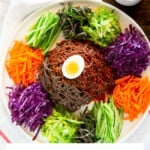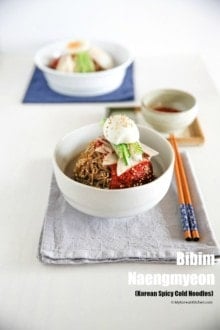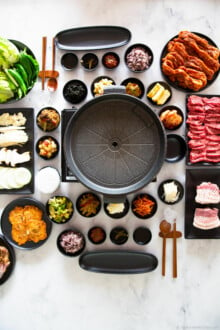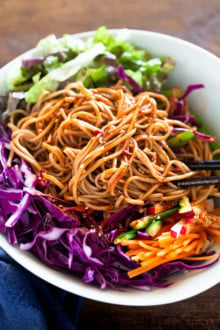Craving something bold, spicy, and refreshing? This Korean spicy noodle salad platter — Jaengban Guksu — is light, vibrant, and ready in about 30 minutes. Tossed in a sweet and tangy gochujang dressing and topped with crisp veggies and eggs, it’s the ultimate summer dish to share with friends or enjoy on your own.
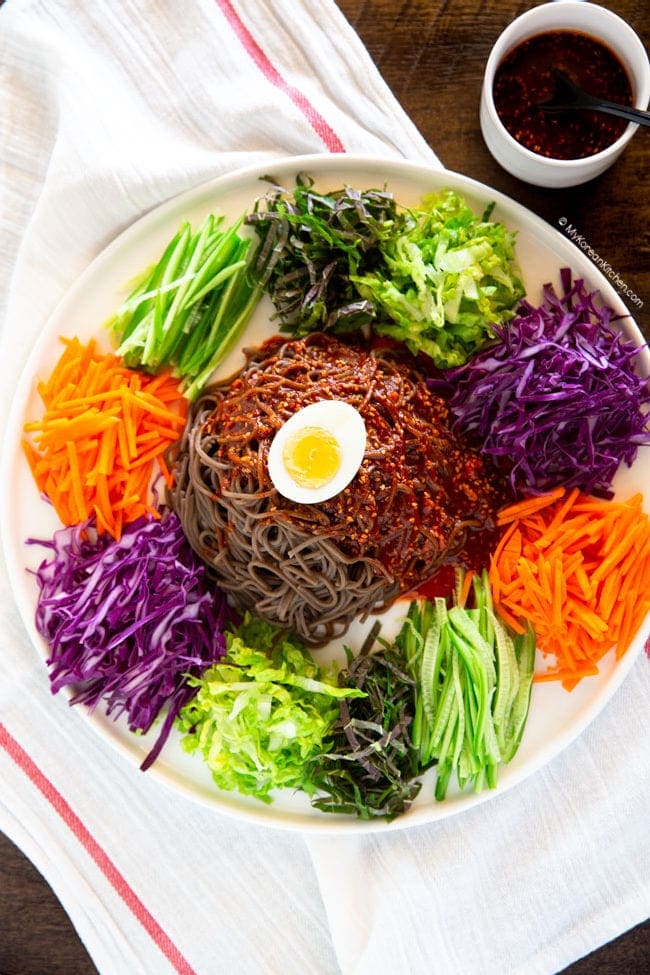
All About Jaengban Guksu (Spicy Korean Noodle Salad Platter)
Jaengban guksu (쟁반국수) is a cold Korean noodle salad served on a large platter with loads of fresh vegetables. Jaengban means platter or tray in Korean, and guksu means noodles.
It’s a type of bibim guksu, or “mixed noodles,” where buckwheat or wheat-based noodles are tossed in a spicy, slightly sweet, and tangy sauce along with colorful, crunchy vegetables — all mixed together into one bold, delicious platter. The flavor is bold, refreshing, and just the right amount of zingy — and the texture is equally invigorating.
You’ll often find jaengban guksu served at bossam (Korean pork wrap) or jokbal (braised pig’s trotters) restaurants, since the bright acidity of the noodles balances rich meats beautifully. I personally love serving it alongside my air fryer pork belly, and it always gets rave reviews.
One of the best things about this dish is how adaptable it is — you can customize the platter with your favorite vegetables, or whatever you have on hand. (Though I’ll admit, julienning veggies can take a bit of time. 😉) The dish is also designed to be shared — usually between two or three people — which makes it even more fun to eat.
While buckwheat noodles are especially popular in Korean summer dishes, jaengban guksu can be enjoyed year-round. It’s light but satisfying, packed with flavor, and beautifully suited to picnics, gatherings, or just a cozy night at home.
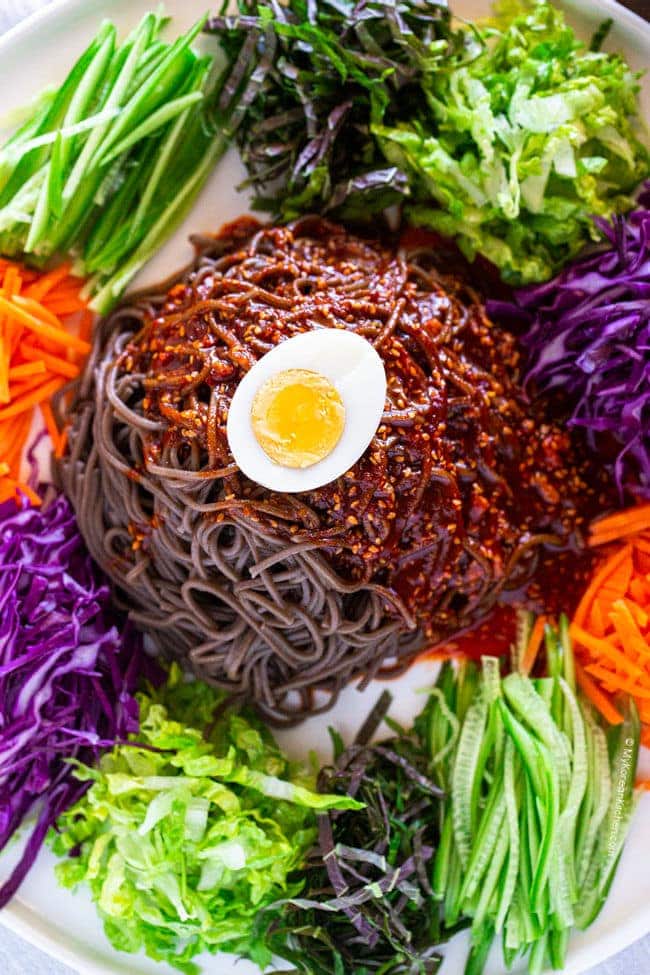
Why You’ll Love This Recipe
- Quick and no-fuss once the veggies are prepped — just boil the noodles and toss everything together.
- Cold, spicy, and full of zippy flavor — super refreshing on a hot day.
- Beautiful to serve and fun to share — perfect for BBQs, gatherings, or a casual weeknight meal.
- Easily customizable with your favorite veggies or whatever you have on hand.
Ingredients for Spicy Noodle Salad (Serves 3–4)
Main
- 50g / 1.7 ounces lettuce (butterhead or baby cos lettuce), thinly sliced
- 5g / 0.17 ounces perilla leaves, thinly sliced
- 100g / 3.5 ounces cucumber, julienned
- 90g / 3.1 ounces carrot, julienned
- 100g / 3.5 ounces red cabbage, thinly sliced
- 2 hard boiled eggs, cut in half length ways
- 200g / 7 ounces soba noodles (buckwheat noodles)
Sauce
- 2 Tbsp gochujang (Korean chili paste)
- 1 Tbsp gochugaru (Korean chili powder or Korean chili flakes)
- 2 Tbsp raw sugar
- 1 Tbsp honey
- 3 Tbsp apple cider vinegar or rice wine vinegar
- 1 Tbsp regular soy sauce (e.g. kikkoman)
- 1 Tbsp sesame oil
- 1 Tbsp sesame seeds
- 1 tsp minced garlic
- 1/2 tsp hot mustard paste
* 1 Tbsp = 15 ml, 1 cup = 250 ml
** If you want to learn more about Korean ingredients, check my essential Korean ingredients list.
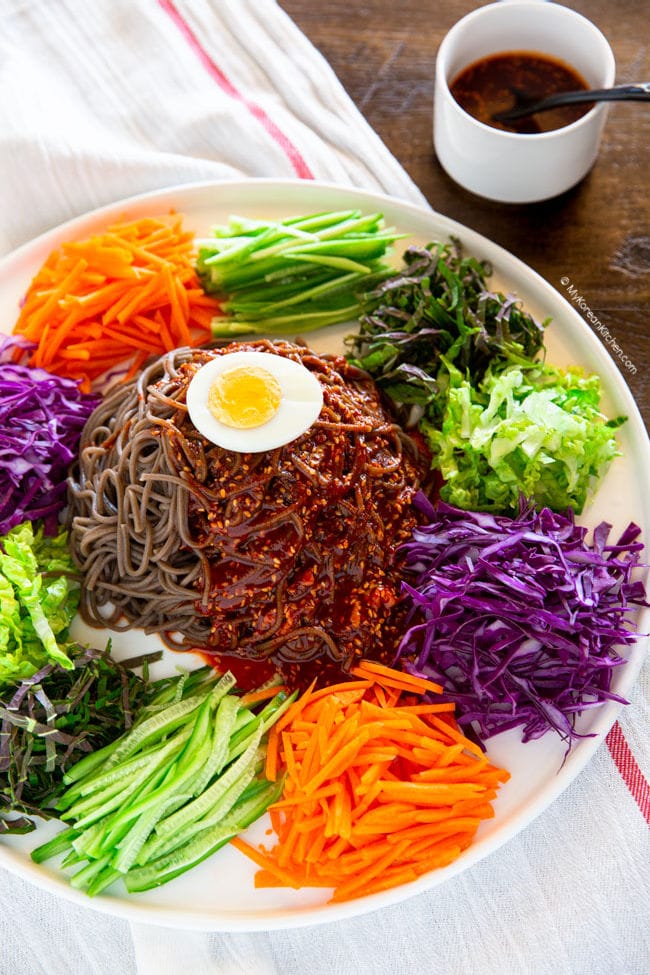
How to Make Spicy Noodle Salad Platter (Jaengban Guksu)
1. Combine the sauce ingredients in a small bowl and mix well. Set aside.
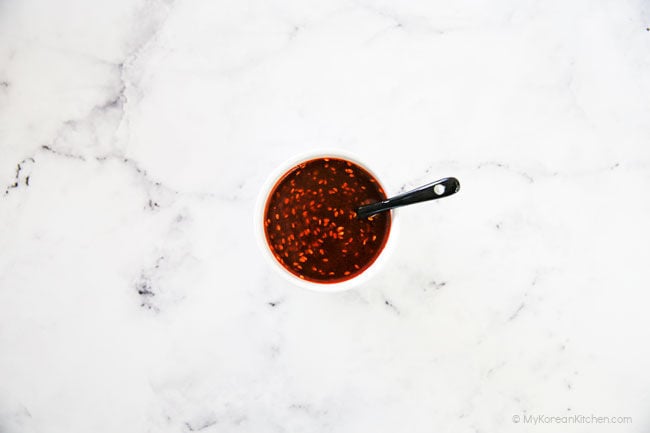
2. Boil some water in a pot over medium high heat. Once boiling, add the noodles and boil for the time instructed on the package. When the noodles are cooked, drain and run some cold water over them to cool them down. Drain.
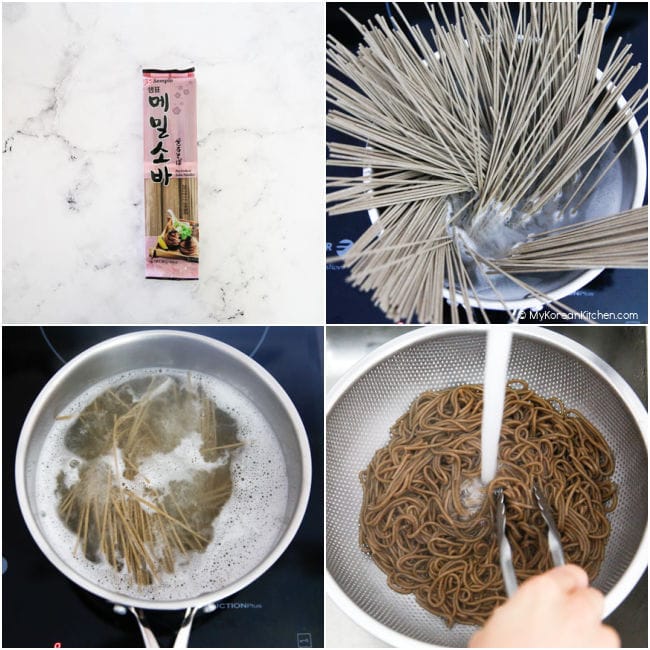
3. Arrange the prepared vegetables on a large platter. Place the noodles in the middle and add the sauce, then top up with boiled eggs.
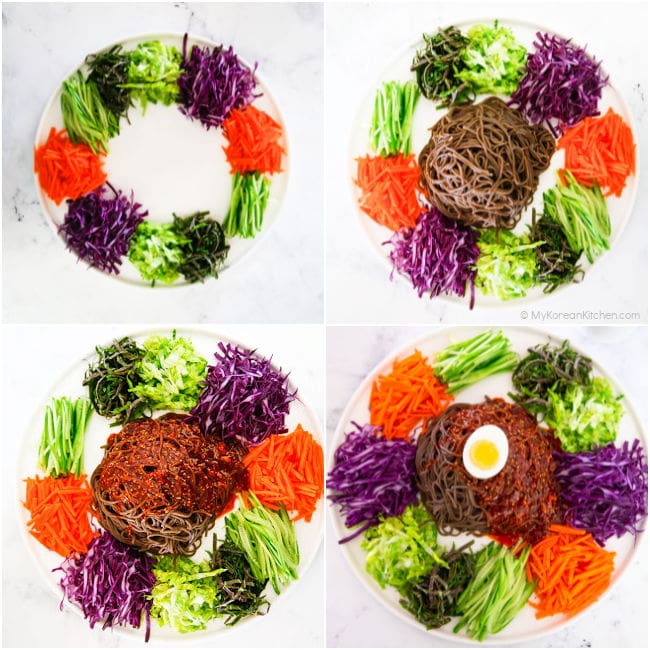
4. Serve. To eat, mix them well with your hands (gloved) or use a pair of chopsticks or tongs.
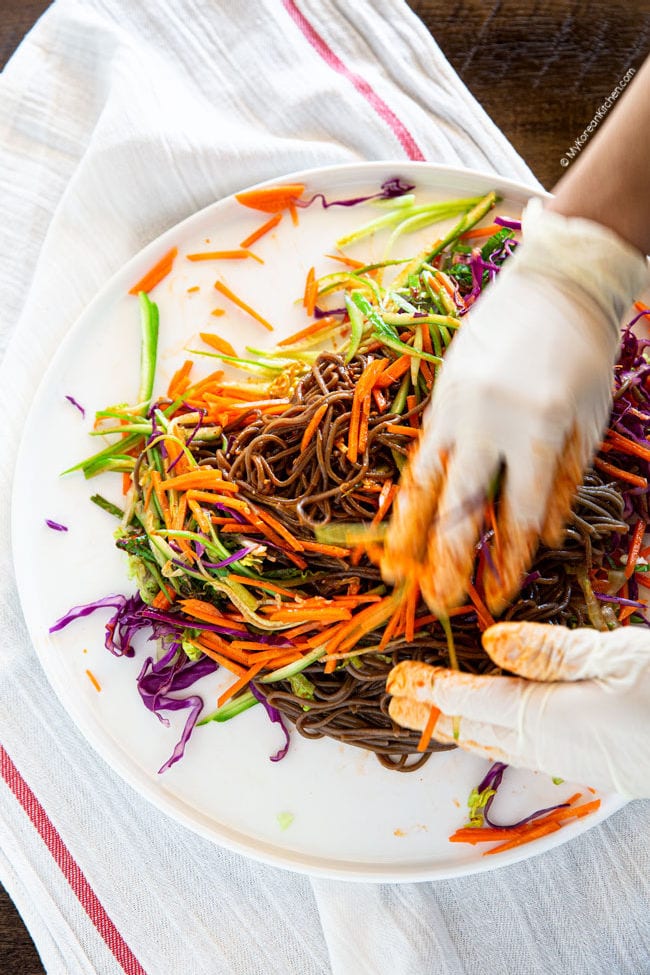
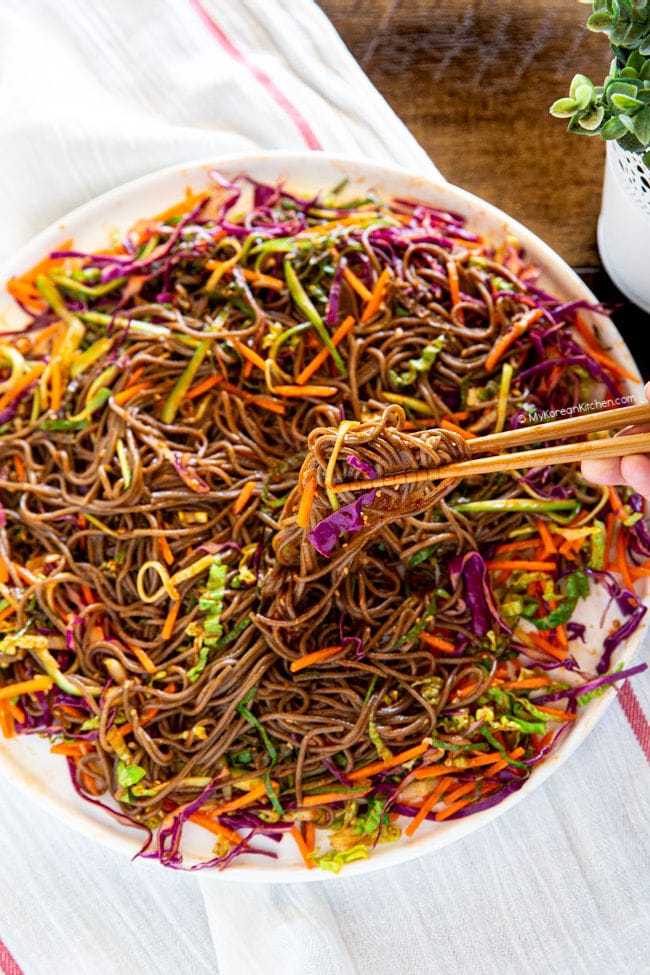
Storage Tips
Best enjoyed fresh, this spicy noodle salad platter still keeps well as leftovers — just store it in an airtight container in the fridge for up to a day. If you’re making it ahead, store the sauce and vegetables separately, and cook the noodles just before serving for the best texture and flavor.
Other Korean Summer Recipes You Might Like
Cool, refreshing, and so satisfying — here are a few of my favorite Korean recipes that are perfect for hot days. Whether you’re looking for something chilled and creamy, tangy and hydrating, or fresh and crunchy, these will hit the spot.
- Kongguksu (Cold Soy Milk Noodle Soup) – A creamy, nutty bowl of chilled noodles served in homemade soy milk broth. Light, refreshing, and incredibly cooling — perfect for a summer lunch.
- Mul Naengmyeon (Cold Buckwheat Noodles in Broth) – Chewy buckwheat noodles in icy cold beef or dongchimi broth. It’s tangy, slurpy, and unbelievably refreshing — one of Korea’s most iconic summer dishes.
- Korean Green Salad – Crisp lettuce, cucumber, and apple tossed in a sweet-tangy Korean soy dressing. It’s the perfect side to cool down your palate between spicy bites.
- Korean Watermelon Punch – A refreshing Korean summer drink made with chilled watermelon, soda or milk, and fruity add-ins. Light, hydrating, and perfect for beating the heat!
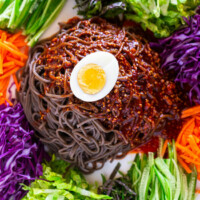
Spicy Noodle Salad Platter (Jaengban Guksu)
Ingredients
MAIN
- 50 g lettuce (butterhead or baby cos lettuce), (1.7 ounces), thinly sliced
- 5 g perilla leaves (0.17 ounces), thinly sliced
- 100 g cucumber , julienned
- 90 g carrot , julienned
- 100 g red cabbage (3.5 ounces), thinly sliced
- 2 boiled eggs , cut in half length ways
- 200 g soba noodles (buckwheat noodles),( 7 ounces)
SAUCE
- 2 Tbsp gochujang (Korean chili paste)
- 1 Tbsp gochugaru (Korean chili powder or Korean chili flakes)
- 2 Tbsp raw sugar
- 1 Tbsp honey
- 3 Tbsp apple cider vinegar or rice wine vinegar
- 1 Tbsp soy sauce , regular (e.g. kikkoman)
- 1 Tbsp sesame oil
- 1 Tbsp sesame seeds
- 1 tsp minced garlic
- 1/2 tsp hot mustard paste
Instructions
- Combine the sauce ingredients in a small bowl and mix well. Set aside.
- Boil some water in a pot over medium high heat. Once boiling, add the noodles and boil for the time instructed on the package. When the noodles are cooked, drain and run some cold water over them to cool them down. Drain.
- Arrange the prepared vegetables on a large platter. Place the noodles in the middle and add the sauce, then top up with boiled eggs.
- Serve. To eat, mix them well with your hands (gloved) or use a pair of chopsticks or tongs.
Notes
- 1 Tbsp = 15 ml, 1 cup = 250 ml
- If you want to learn more about Korean ingredients, check my essential Korean ingredients list.
The nutrition information shown is an estimate provided by an online nutrition calculator. It should not be considered a substitute for a professional nutritionist’s advice.
